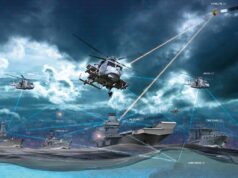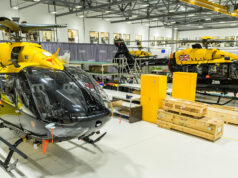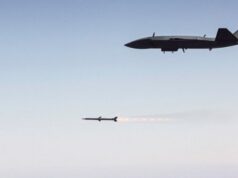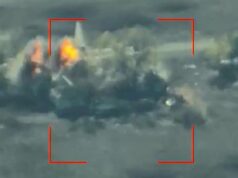Bell Textron Inc has announced a new rotorcraft, the Bell 360 Invictus.
The aircraft serves as the company’s entrant for the U.S. Army’s Future Attack Reconnaissance Aircraft (FARA) Competitive Prototype programme.
“The Bell 360 will deliver advanced battlefield situational awareness, as well as lethal options, in support of the maneuver force at an affordable cost” said Vince Tobin, executive vice president of Military Business at Bell in a news release.
“The multi-domain fight will be complex, and our team is delivering a highly capable, low-risk solution to confidently meet operational requirements with a sustainable fleet.”
The Bell 360 Invictus’ design, say the firm, emphasises proven technologies to fulfill the Army’s FARA requirements at an affordable cost and on schedule.
“One example is the Invictus’ rotor system. This design is based on Bell’s 525 Relentless rotor system which has been tested and proven at speeds in excess of 200 Knots True Air Speed (KTAS). By incorporating proven designs and the best available technologies from commercial and military programs, Bell delivers a low-risk path to a FARA program of record.”
Some of the key 360 Invictus features include:
- Speed: Greater than 185 KTAS
- Combat radius: 135 nm with more than 90 minutes of time on station
- Achieves 4k/95F Hover Out of Ground Effect (HOGE)
- Armed with a 20 mm cannon, integrated munitions launcher with ability to integrate air-launched effects, and future weapons, as well as current inventory of munitions

“Bell is committed to providing the U.S. Army with the most affordable, most sustainable, least complex, and lowest risk solution among the potential FARA configurations, while meeting all requirements,” said Keith Flail, vice president of Advanced Vertical Lift Systems at Bell.
“360 Invictus is an exciting opportunity for us to continue our support of Army modernization. This is the next solution to ensure soldiers have the best equipment available for the multi-domain fight.”













Looks nice and it’s faster than Apache, but I’ve always loved the Apache, oh and Air wolf obviously, who doesn’t that gun ship can take out nations.
Don’t forget whisper mode and engage the burners to go supersonic….
Lol
One of my favorite shows as a kid.
Based on a true story too…..
Airwolf was based on?
Looks like the Boeing- Sikorsky RAH-66 Comanche
Yes I was going to say it looks very familiar and that was the bird I had in mind. Seems like Boeing didn’t burn the blueprints then when it was cancelled all those years ago and perhaps passed them on or is it just coincidence? Trouble is (assuming it has the same heritage) it might make it cheaper but generally the more you try to bring an older design up to date it often loses most, or all of that advantage as you wrestle with inbuilt limitations to adapting to a new world, while rarely matching newer concepts designed from the ground up to accommodate them in potential. The US to be fair are probably the best at getting round that seeming drawback but thats when the costs start to bite. It might however after so much development still be more reliable I guess though when I read the ‘retains the proven rotor system’ I do remember the number of proven systems that didn’t prove reliable at all when put into a different set up over the decades.
Definately from the RAH 66 bloodline.
Bell have been very clever with their proposal. Rather than going down the risky tilt-rotor, co-axial or convertiplane route, they’ve opted for the traditional route. This is to keep costs down but also for its simplicity. One of the US Army’s Future Attack Reconnaissance Aircraft (FARA) requirements is that the aircraft must be able to sustain a speed of 200kts. The aircraft that the Invictus is based on is the Bell 525, which has managed 229, but that wasn’t a sustained speed.
Bell are being a bit coy on how the aircraft will be able to do these speeds. Traditionally, helicopters struggle to get past 180kts. Once past this number the crew start suffering from vibration fatigue as the aircraft’s inherent vibration builds up. In fact the first Bell 525 prototype crashed due to uncontrolled vibration from the tail affecting the flying controls. At close to 200kts the helicopter’s blade tips will be in the high transonic zone, with some parts even going supersonic (dependent on local air pressure and temperature). Rotor blades are not designed to go supersonic, they will shatter as they are designed to be flexible to allow for blade flapping i.e. where the blades disc cones goes upwards or downwards. They also have a limited amount of blade lag, where the air pressure forces the blade back against the aircraft’s forward movement. If you build a blade to go supersonic, it would need to be very rigid so couldn’t flex, though increasing the lag may help, which means going through air pockets, attaching heavy under-slung loads etc would snap the blades.
So how will they do it? The picture is very basic and it clearly shows they don’t use a Berp style of tip. These allowed a stripped down Lynx to cover a 15km course at an average of 216 knots. The Gems were maxed out and were buggered after use. There is one clue in the picture, it has a large wing. The theory being the wing can offload the rotor disc requirement to generate lift and thrust. This is one part of the story, the other is that they probably slow down the rotor rpm. This sounds counter-intuitive, but by doing so the blade tips local airspeed can then drop in the low transonic zone. Airbus are doing this with the experimental X3 helicopter, but they also have a pair of pusher propellers to help. The Invictus clearly doesn’t, so it must just be using the tilting disc to generate the speed they require. I’m still not certain that this will get the necessary speed required for the Army’s requirement though.
Does look very Commanche though!
That was very helpful, excellent even. Did you write that from personal knowledge or research, either way good read, thanks.
Personal knowledge as I’m in the trade. The Airbus X3 is going in the right direction for simplicity and speed. It’ll be interesting to see what they do after the X3.
Thanks. In Somerset?
Hampshire, at present.
+1, great info, well written.
What got the RAH-66 Comanche cancelled was the cost mixed with complexity and use of emerging bleeding edge technologies. You can learn so much about a product from what lines the sales bod has been told to regurgitate.
“Bell is committed to providing the U.S. Army with the most affordable, most sustainable, least complex, and lowest risk solution among the potential FARA configurations, while meeting all requirements,”
Translation: (key capabilities in priority order), Cheap to buy, cheap to run, not complex and mature. Its almost like they used the Comanche project as a blueprint on what not to do.
I like this, as I am myself not complex, cheap and way too mature to do the job I am doing.
BV
My memory seems to have fragments of thoughts that the Comanche was not the only advanced helicopter that totally got out of control back in the day they really got burnt fingers with trying to push the envelope beyond the possible at an affordable price even for them. The Cheyenne comes to mind I did love that copter I must say that I had forgotten it had a pusher propellor till just looking it up, so seems the Comanche isn’t the only one to die but have an influence on design some years later.
Wow! Very informative! thanks for sharing
Have Bell been to any DOD surplus sales recently?….. It looks very much like the Boeing/Sikorsky RAH-66 Comanche. I’m surprised the future Apache concept that was came out a few months back doesn’t resemble it more.
I assume this offering from Bell is to replace the OH58 Kiowa’s. nice looking aircraft but I have to say the graphic representations make it look very James Cameron’s Avatar-esqe. I wonder how long before we see some contractors concepts of the Aerospatiale SA-2 “Samson” & AT-99 “Scorpion” Gunships that featured in the film.
Why only a 20mm canon?
Gun is likely gun a carry over from the Cobra which Bell still makes and could install with the least risk.
A better write up of the Bell proposal is at: https://www.thedrive.com/the-war-zone/30136/no-bells-invictus-armed-scout-helicopter-isnt-stealth-but-it-aims-to-be-fast-and-cheap – also touches on the cannon selection. In short this is the same canon that was proposed for the RAH-66 Comanche and is being provided GFE to each of the FARA candidates.
FARA is to be an armed recce helicopter with a light attack capability not a full on attack helo to replace apache. It probably doesn’t need a heavier gun.
I would also assume a larger caliber will also be bigger and heavier (including ammo) which will have significant performance and integration issues, particularly if you have to recess it for aerodynamic and stealth considerations….
Why am I thinking Comanche the sequel – the plot will go something like:
•We want it, we want it, we want it, we want i and now!
How much ?
We don’t need it – stand back from the door sir. Slam!!!
Love the looks, however at an estimated $30m per unit, compared to a Kiowa at $5m really makes me question the usefuleness of this concept. For that price may as well buy new Apaches which have more armor and firepower. Furthermore, they have just bougth Lakota that can be fitted with optics, guns etc.. for a fraction of the price. Seems like another wasteful US Army project which really brings nothing new except an arbitrary speed requirement of 200kts. I guess some bureaucrats at the Pentagon must justify their job titles.
The Kiowa only cost that much because it was a existing system being upgraded not a new development program. In addition $5m in 1990 is worth approximately $9.6m today.
looks like a good replacement for the cobra, a traditional design though- I think the Raider-X might win it for superior high altitude and cruise/ top speed performance.